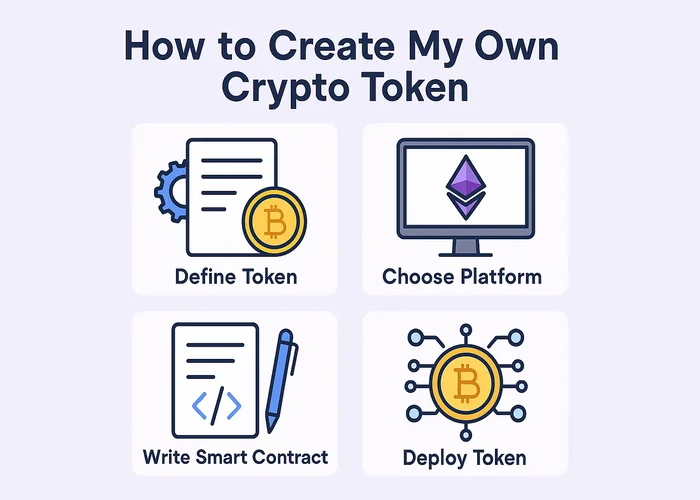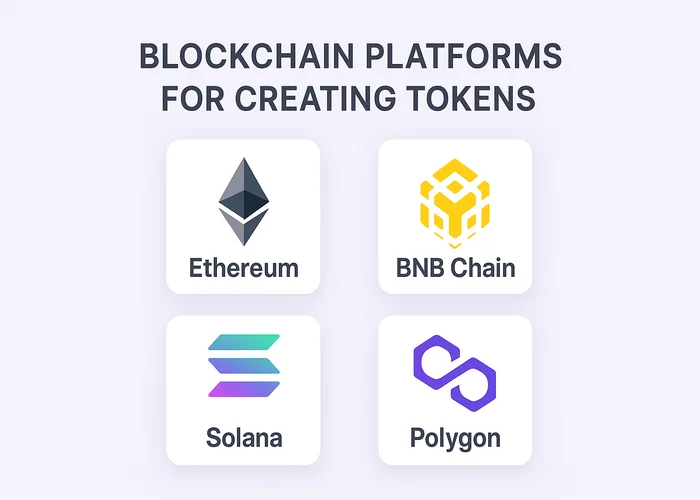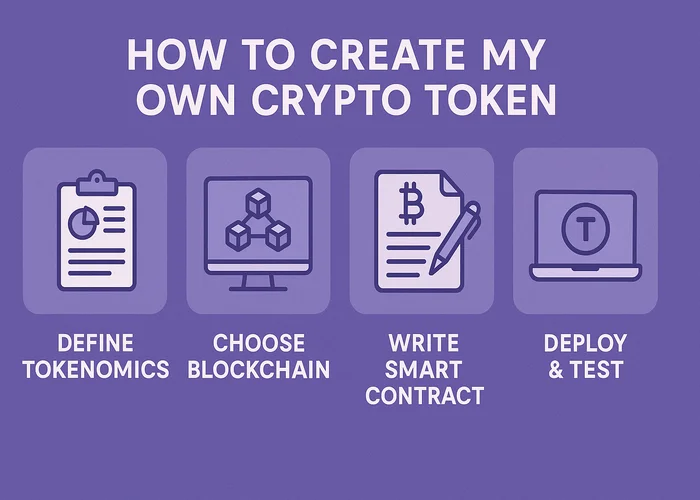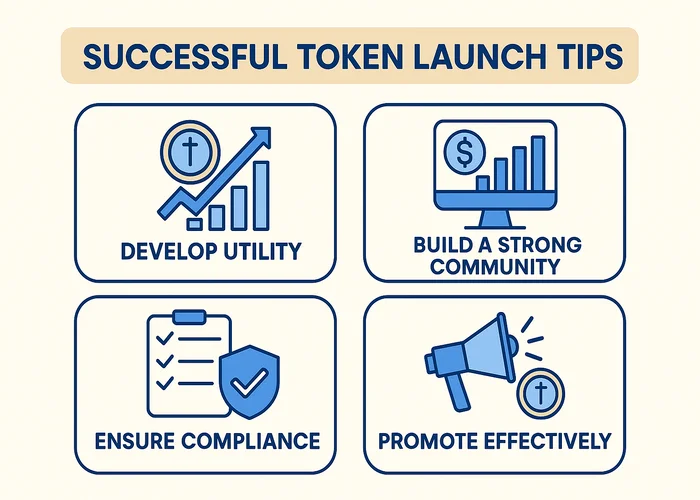With the advanced technology like blockchain, it is very simple to create my own crypto token. This has never been easier or simpler. Launch you own token can help entrepreneurs, developers and many firms with new fundraising opportunities.
This guide covers everything from token’s purpose to launch and promotion and How Much Does It Cost To Create A Cryptocurrency. The finest blockchain systems, pricing, and how to make a crypto token and protect, comply, and succeed with your token will also be discussed.
Why Should You Create My Own Crypto Token?
Before learning the technical aspects, you should know why you want to construct a crypto token. Tokens are digital assets based on Ethereum, BSC or Solana. Instead of native cryptocurrency networks like Binance and Ethereum, you can create my own crypto token on any of the networks. To create your own tokens, use these networks’ security and infrastructure for usefulness, governance, asset representation, and access rights.
Decentralized finance, NFTs, gaming, and community governance use tokens. To create my own crypto token, first grasp its purpose. Will it fuel a dApp, reward users, or symbolize project ownership? Define your token’s use case to guide its design, supply, and distribution.
Blockchain platforms for creating tokens
Ethereum
The largest and most popular token network is Ethereum. Here are some Ethereum ERC-20 token building concerns.
- Transaction Fees: The Ethereum blockchain network can increase gas fees which may affect projects and impact the transaction costs.
- Security: With number of nodes that is used and also with the help of vibrant developer community, Ethereum’s tested infrastructure is secure.
- Ethereum’s large and active community provides developers with resources, documentation, and assistance.
BNB Smart Chain
BSC, launched by Binance, is cheaper and faster than Ethereum. BSC tokens are BEP-20-compliant.
- Transaction fees: BSC has low transaction fees, making it appealing to cost-conscious projects.
- Security: BSC has a validator set and Binance backing that makes it more secure and centralized whic may make the decentralizers think about it.
- Though younger than Ethereum’s ecosystem, BSC’s community has grown rapidly and offers a variety of tools and support.
Solana
Solana is one of the very popular blockchain platforms used for token development. This is because of its strong performance, fast transaction rates and low fees. SPL-compliant tokens are built on the chain.
- Transaction fees: Solana has low transaction costs, which benefits projects with big transaction volumes.
- Security: Solana uses Proof of History (PoH) for security and scalability. As a newer platform, it may not have as much security as Ethereum.
- Support: Solana’s community is growing, with more information and developer tools.
How to Create My Own Crypto Token?
Thinking about How To Create Your Own Cryptocurrency For Business, Here are the steps to create your own crypto token. Read this completely, create Your Own Cryptocurrency and Make Money.
Step 1: Define Your Purpose
Create my own crypto token by defining its purpose. Know the problem or niche your coin solves to determine its aim. It might be about speedier transactions, lower fees, or offering investors a new alternative. A defined objective guides development.
Choose the Audience
Know who your cryptocurrency is for. You may target techies, investors, or an industry. Knowing this helps you design features and marketing strategies.
Cryptocurrency Use Cases
Determining how to use cryptocurrencies is crucial. It can be used for everyday trading or finance or supply chain. Real-world examples demonstrate its worth and market position.
The Economic Model and Tokenomics
A good economic model is essential for digital asset success. Tokenomics covers token creation, sharing, and pricing. Balanced approaches attract consumers and investors. This fosters token growth.
2: Select a Consensus Mechanism
Choosing the appropriate consensus method is vital for cryptocurrency success. It securely stores transactions on the blockchain without a central authority. Consider these key consensus mechanisms:
Proof of Work
Bitcoin miners utilize Proof of Work to solve complicated issues. It is secure but energy-intensive due to its computational power.
PoS
Validators build blocks and examine transactions in Proof of Stake. Validators are chosen by coin stake. It encourages long-term investment by using less energy than Proof of Work.
Delegated PoS
Token holders vote for network validators via Delegated Proof of Stake. It combines centralization and decentralization for speed and transparency.
Practical Byzantine Fault Tolerance
Practical Byzantine Fault Tolerance prioritizes energy efficiency and consensus. Network nodes validate transactions together, making private blockchains ideal.
Hybrid Consensus
A hybrid technique combines Proof of Work and Proof of Stake. They seek energy efficiency, scalability, and security. Their combined strengths are making these popular.
Step 3: Select a Blockchain Platform
Choosing the correct blockchain platform is crucial to project success. Each has unique characteristics and scalability. They suit diverse goals.
Ethereum
Ethereum is best for its ecosystem, DApps, and smart contracts. Widely used, it gives developers several tools. Community support helps them efficiently produce new coins.
Binance Smart Chain
BSC is affordable and it will work across different chains. This is great for DeFi app developers. It performs well and costs less.
Polkadot
Polkadot is unique in enabling blockchain collaboration. This is for developers that want their currencies to work with several blockchains.
Cardano is distinguished by its scientific foundation and multi-layer structure. Security and scalability make it perfect to create my own crypto token and smart contract foundations.
Alternative Blockchain Platforms
Other platforms like Solana, Tezos, and Avalanche offer functionalities. We recommend investigating them to discover the appropriate fit for your project.
Step 4: Design the Nodes
Any blockchain needs nodes to share and store data. Understanding node types is crucial for a healthy cryptocurrency network. Each category contributes differently to network effectiveness.
So What Are Nodes?
Blockchain nodes discuss network-joined devices. They verify transactions and maintain the blockchain. A node may store all or part of the blockchain ledger, depending on its role.
Full vs. Light Nodes
Different demands and jobs for full and light nodes:
Full Nodes: Nodes store the blockchain and authorize transactions and blocks. Blockchain integrity and safety are protected.
Light Nodes, also called lightweight clients, solely store transaction-related data. Because they need full nodes for blockchain data, they utilize less resources.
Centralized vs. Decentralized Nodes
The configuration of nodes affects blockchain security and control:
Centralized nodes have one or more controllers. It means more control and less decentralization.
Decentralized Nodes: Spreading nodes increases security and network resilience.
Configuring and Maintaining Nodes
A smoothly running cryptocurrency requires proper node setup and maintenance. This requires preparing nodes for the workload, updating software for security, and monitoring performance.
All these procedures ensure network safety and efficiency:
Node configuration: Setting up the node for network needs such storage and connection.
Maintenance: Nodes need regular software updates and checks to stay healthy and the blockchain running.
Finally, a cryptocurrency blockchain’s success depends on choosing and maintaining the correct node setup.
Step 5: Establish Blockchain’s Internal Architecture
Strong blockchain internal architecture is essential. It underpins a secure and effective cryptocurrency. Permissions, address formats, keys, data storage, and smart contracts are included.
Permissions
Permissions determine network membership. Only approved users can join a permissioned blockchain. This maintains order. All are welcome on a permissionless blockchain. This transparency promotes participation and decentralization.
Address-format
Proper address formatting is vital. Secures and verifies transactions. Each blockchain has its own address specifications to work efficiently.
Key Management
Safely managing cryptographic keys is crucial. These keys secure blockchain transactions and user assets.
Store and Retrieve Data
Data storage and access must be efficient for a blockchain to expand. Data handling should be fast, secure, and efficient. This allows it to handle more transactions smoothly.
Smart Contracts, Automation
Automation and rule application in blockchain transactions require smart contracts. They make agreements run well without trusting others, improving network dependability and features.
Step 6: Integrate APIs
APIs are essential for cryptocurrency integration. They help developers improve projects. This makes digital money transactions safe and quick.
Private and public APIs
With public APIs, outside developers can tap into your platform’s data or features. This encourages collaboration. In contrast, private APIs are used internally. They protect sensitive platform sections for critical tasks.
Crypto wallet API
Users need a cryptocurrency wallet API for financial transactions. It offers the groundwork for safe, simple wallets. So, users may better manage their digital funds.
Exchange APIs
Your platform needs exchange APIs to offer trading. They provide live trade data. This allows users to trade, purchase, and sell easily.
Payment Gateway APIs
Payment gateway APIs are important for digital currency’s wider use. They simplify cryptocurrency acceptance for businesses. This brings digital money into the mainstream. Programmers can introduce payment choices to make platforms more user-friendly.
Step 7: Design the Interface
Good interfaces are crucial to Bitcoin’s success. It requires front- and back-end programming. This guarantees a fantastic experience and high security. Let’s examine these parts.
Front-end coding
Front-end programming helps with the interfaces and it can work well. Programmers use HTML, CSS, and JavaScript. The site should be easy and interesting to use, keeping users interested.
Back-end programming
Back-end programming is behind the scenes. It ensures data and transaction integrity. Strong back-end systems may use Python, Java, or C++. The UI runs well with good back-end work.
UX Experience Design
UX design makes interfaces user-friendly. It involves user research and design testing. We want to satisfy users so they stay.
Best practices and security features
Security features are essential today. Encryption, various access checks, and safe code are essential. These steps secure the platform and users.
Step 8: Make Your Cryptocurrency Legal
Legalizing cryptocurrency is crucial. It builds user trust.
Compliance with International Law
To ensure global cryptocurrency acceptance, obey international legislation. Each nation regulates digital currency. Compliance enhances your offer and avoids legal difficulties.
Local laws
Local laws matter too. Every place has different crypto business requirements. Legal issues can be avoided by following these regulations and registering with regulators. It also requires ethical business practices.
AML and KYC Regulations
Safe and legal cryptocurrency requires solid AML and KYC rules. These regulations demand user verification and suspicious transaction monitoring. Following these standards keeps your business and everyone safe.
Taxes and Reporting
Taxes and reporting must be understood. Know your crypto taxes in different areas. This means you meet financial obligations and avoid fines. Open and accurate reporting fosters user and authority trust.
Step 9: Promote Your Cryptocurrency
In bitcoin, standing out is crucial. A smart marketing plan helps. It helps your crypto project gain credibility. Online marketing, community engagement, collaborations, and bounty programs matter. They foster community, attract investors, and raise growth capital.
Openness and communication are key to a strong start. Inform individuals of fresh plans and news. Participate in forums and social media. Crowdfunding like ICOs is clever. It demonstrates your work and why investors care.
Legal and Regulatory Considerations
Before launching a token, consider legal and regulatory requirements:
Check local securities laws to see if your token is a security. Register it and follow disclosure laws if necessary.
AML/KYC: Prevent illegal operations and comply with legislation with AML and KYC procedures.
If you target EU users, comply with data protection requirements like GDPR.
To avoid costly blunders, hire a crypto token development company. They offer you complete guidance and support.
Successful Token Launch Tips
Here are some tips to help you generate and profit from cryptocurrency:
The value of the token makes it more special and valuable.
Transparent Tokenomics: Disclose token distribution and use.
Security First: The token development using the best blockchain platforms helps the users to protect with security audits and best practices.
Community Engagement: Create my own crypto token – a vibrant project community.
Ensure your token has enough liquidity and is listed on respected exchanges.
You can also create a crypto token on Solana. For more tips and strategies you might need to hire ERC20 Token Development Companies and BEP20 Token Development Companies.
Common Mistakes to Avoid:
If you can’t define or decide the purpose of the token, it will affect its growth, and its usefulness might be at stake.
Bypassing the crucial security steps or testing will largely affect the token and leads to less performance, money loss and vulnerability among the users.
Tokenomics that is too complicated or unjust can repel users and investors.
Neglecting Marketing: Without promotion and community building, even the best token will fail.
Not complying with regulations can lead to fines, legal action, and reputational damage.
How to Launch a Crypto Token for Business?
This section will help you with how to launch a crypto token. Create my own crypto token for business using the same procedure but with additional considerations:
Your token should match your business goals and value proposition.
Compliance: Create my own crypto token and make sure your token follows local and international legislation.
Partner with other companies or platforms to boost adoption.
Integrate your token into your products or services for real-world use.
Conclusion:
How to build a crypto coin is largely dependent on the project value, technical expectations and decided budget. Create my own crypto token from scratch will need a technically sound crew like bunch of token developers and token development company.
Launching your own token and joining the blockchain innovation world requires defining your objective, picking the proper blockchain, designing sound tokenomics, implementing and testing smart contracts, executing a successful marketing campaign and understanding how much does it cost to create your own crypto token.
Consider costs, legal constraints, and security and community building best practices. With the correct planning and resources, you can build your own crypto token and profit from blockchain.
Connect with us to explore more options to create your own crypto token. Talk to us today.





